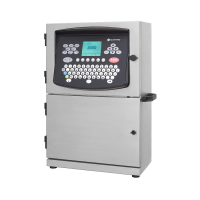PRINTER DESCRIPTION
27080 Issue 1 September 98 6--19
throughstationary ink. Its movement down the tube is timedandthis
time is used as the viscosity check.
If the ink is too thick, make--up is added into the ink reservoir by
openingthemake--upsolenoidvalve. Thesuctionprovidedbythelow
pressure (gutter) pump head then draws in make--up from the
make--up reservoir and passes it with the gutter ink into the reservoir.
Auto--flush. Shutting down the printer involves an automatic flush
cycletopreventtheprintheadbecomingdirtywithinksplashes. When
the ink jet is turned off, the head and feedsolenoidsareturned off and
the flush and bleed solenoids are opened. The vacuum created by the
jet pump draws fluid from the make--up reservoir to the bleed circuit
via the printhead. The wash and printhead valves are then opened to
enable the make--up in the bleed line to pass through the nozzle.
Thehead iscleanedbytheflowof make--up during theflushcycle,the
printhead and wash solenoids are then closed. The flush period is
extendedto allowtheguttertobeemptied, andthen the main pumpis
stopped. Finally the bleed solenoid valve is opened temporarily to
release the pressure in the drop generator.
CAUTION Do not switch the printer off before the flush cycle is
complete.
Venting. The ink reservoir is connected to a vent at the bottom of the
cabinet. This allowsforvariationsin the ink leveland forair drawnin
bytheinkandmake--upcartridges. Italsoallowsairdrawninthrough
the gutter to be released. These air movements could result in the
emission of solvent fumes and an evaporation loss. To reduce the
evaporation loss, an optional peltier device can be fitted to cool and
condenseanyescapingvapour. Theresultingliquidispassedbackinto
the make--up reservoir.

